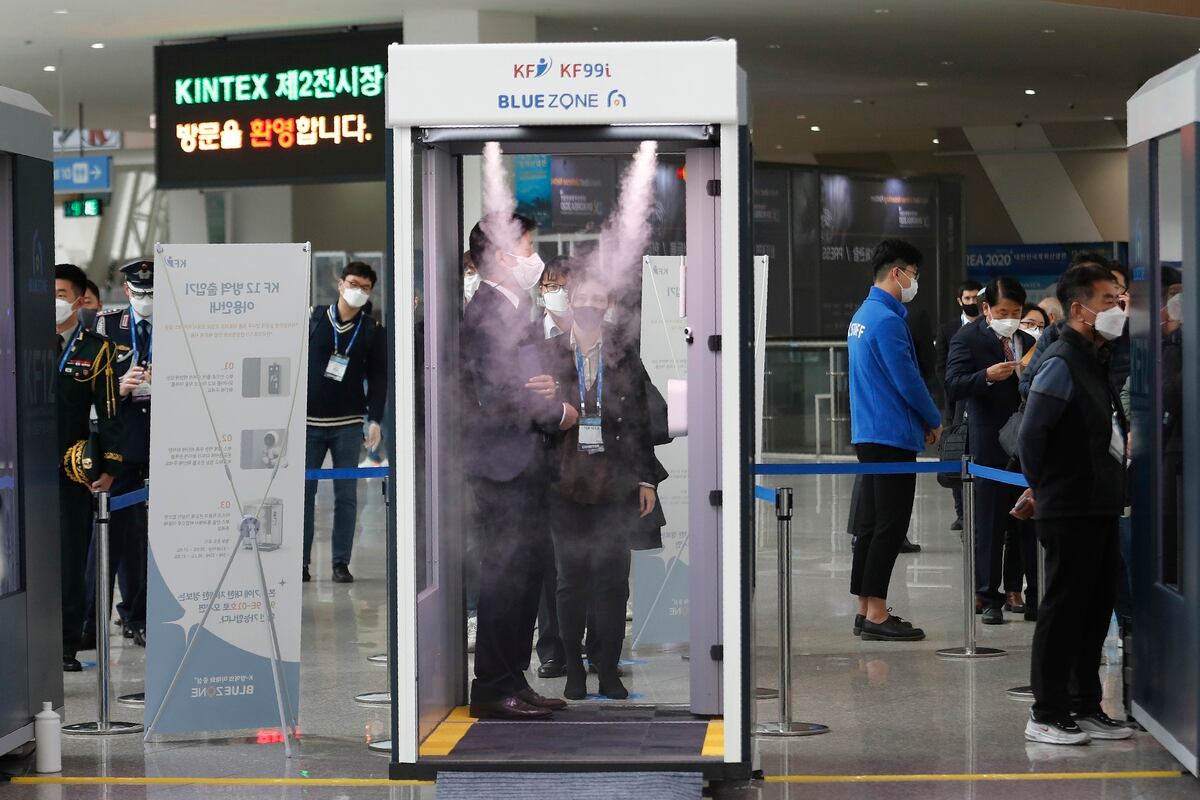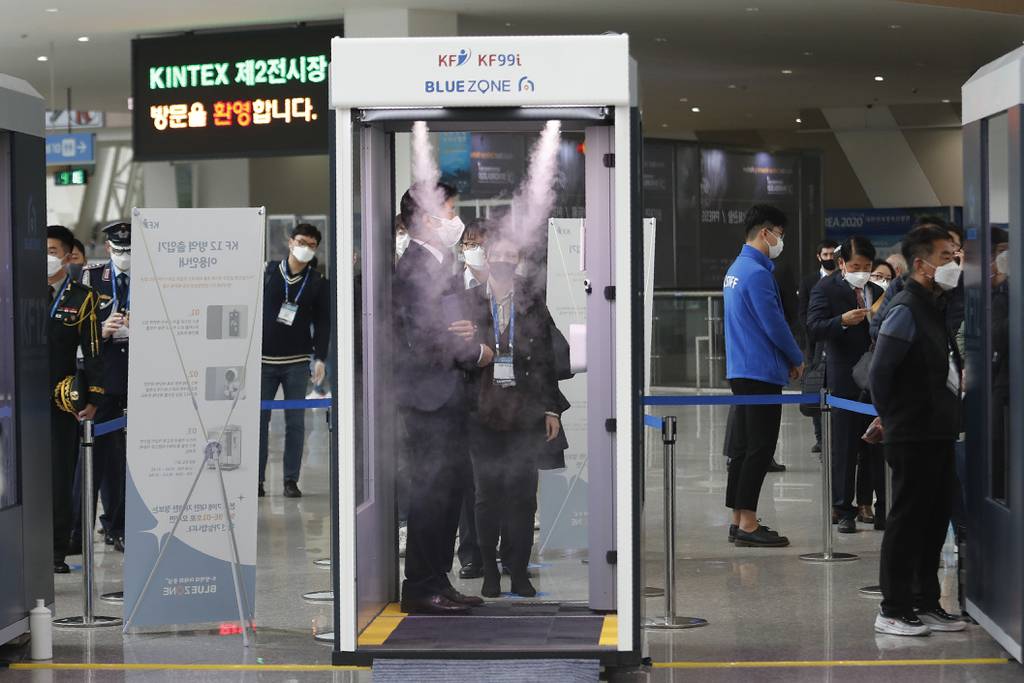By: Brian Kim

SEOUL — Unmanned defense systems and advanced weapons to counter drone threats dominated an arms exhibition held outside of Seoul, South Korea, this week.
During the biennial DX Korea event, which ran Nov. 18-20, local defense companies showcased their cutting-edge unmanned and counter-drone technologies.
Hanwha Corporation, a leading developer of guided-missile technology and subsidiary of Hanwha Group, displayed its new family of laser weapons systems. The company unveiled two types of anti-drone laser weapons: one for installation on light tactical vehicles, and the other a laser-based anti-aircraft weapon gun in a container configuration. The latter, designated as Block I, can be modified to a Block II self-propelled system, but specifications were not disclosed.
Hanwha Corporation is a partner in an anti-drone laser weapons development project led by the government’s Agency for Defense Development.
“The laser-based anti-aircraft weapon is a new concept of armament to shoot down small aerial targets, including drones and multi-copter with a light source laser,” the company said in a news release. “Prototypes of the laser weapon variants are under development jointly with the ADD.”
Hanwha Corporation unveiled two types of anti-drone laser weapons at DX Korea 2020. (Courtesy of Hanwha)
The company also displayed anti-jamming equipment that can be fitted in tactical guided missiles as well as on military vehicles and naval vessels.
Hanwha Systems — also an affiliate of Hanwha Group — displayed a mock-up of its personal air vehicle, Butterfly, under development with U.S. air taxi startup Overair. In partnership with Overair, Hanwha Systems plans to fully develop the electric vertical-takeoff-and-landing, or eVTOL, vehicle by 2040, with an eye toward military sales.
Sign up for our Unmanned Systems newsletter
Every two weeks, get the exclusive, inside look at the challenges and opportunities drone tech presents
Subscribe
“With technologies to be accrued from the development of commercial eVTOL, we will push for developing a military variant capable of conducing multiple missions, including special operations, transport and assault,” the company said in a news release.
Hanwha Systems displayed a mock-up of its personal air vehicle, Butterfly, at DX Korea 2020. (Courtesy of Hanwha)
Meanwhile, Hyundai Rotem presented its HR-Sherpa unmanned ground vehicle designed to support infantry troops.
The six-wheel drive vehicle can move autonomously or via remote control to perform missions such as surveillance, medical support and chemical detection. It has a payload of 600 kilograms and a combat weight of 1,800 kilograms. It is equipped with airless tires and powered by a battery with an operating time of six hours when traveling at 5 kph.
South Korean police officers pass by an HR-Sherpa unmanned ground vehicle on display in Busan, South Korea, on Nov. 24, 2019. (Ahn Young-joon/AP)
LIG Nex1 showcased the third version of its Sea Sword unmanned surface vessel for riverside defense, following other naval variants.
The vessel adopts a high-speed monohull design and is constructed with fiber-reinforced plastic. Equipped with a diesel engine and a waterjet propulsion system, the boat can sail at a maximum speed of 40 knots and has an operational endurance of up to eight hours at 15 knots.
An indigenously developed autonomous navigation system enables the vessel to carry out surveillance and reconnaissance missions based on a preprogrammed route.
Hanwha group was ranked 32nd in Defense News’ list of the top 100 defense companies in the world. LIG Nex1 was ranked 68th, while Hyundai Rotem was ranked 95th.

 www.defensenews.com
www.defensenews.com

An attendee of DX Korea 2020 stands in a sterilizer as a precaution against the novel coronavirus on Nov. 18, 2020. (Ahn Young-joon/AP)
SEOUL — Unmanned defense systems and advanced weapons to counter drone threats dominated an arms exhibition held outside of Seoul, South Korea, this week.
During the biennial DX Korea event, which ran Nov. 18-20, local defense companies showcased their cutting-edge unmanned and counter-drone technologies.
Hanwha Corporation, a leading developer of guided-missile technology and subsidiary of Hanwha Group, displayed its new family of laser weapons systems. The company unveiled two types of anti-drone laser weapons: one for installation on light tactical vehicles, and the other a laser-based anti-aircraft weapon gun in a container configuration. The latter, designated as Block I, can be modified to a Block II self-propelled system, but specifications were not disclosed.
Hanwha Corporation is a partner in an anti-drone laser weapons development project led by the government’s Agency for Defense Development.
“The laser-based anti-aircraft weapon is a new concept of armament to shoot down small aerial targets, including drones and multi-copter with a light source laser,” the company said in a news release. “Prototypes of the laser weapon variants are under development jointly with the ADD.”
Hanwha Corporation unveiled two types of anti-drone laser weapons at DX Korea 2020. (Courtesy of Hanwha)
The company also displayed anti-jamming equipment that can be fitted in tactical guided missiles as well as on military vehicles and naval vessels.
Hanwha Systems — also an affiliate of Hanwha Group — displayed a mock-up of its personal air vehicle, Butterfly, under development with U.S. air taxi startup Overair. In partnership with Overair, Hanwha Systems plans to fully develop the electric vertical-takeoff-and-landing, or eVTOL, vehicle by 2040, with an eye toward military sales.
Sign up for our Unmanned Systems newsletter
Every two weeks, get the exclusive, inside look at the challenges and opportunities drone tech presents
Subscribe
“With technologies to be accrued from the development of commercial eVTOL, we will push for developing a military variant capable of conducing multiple missions, including special operations, transport and assault,” the company said in a news release.
Hanwha Systems displayed a mock-up of its personal air vehicle, Butterfly, at DX Korea 2020. (Courtesy of Hanwha)
Meanwhile, Hyundai Rotem presented its HR-Sherpa unmanned ground vehicle designed to support infantry troops.
The six-wheel drive vehicle can move autonomously or via remote control to perform missions such as surveillance, medical support and chemical detection. It has a payload of 600 kilograms and a combat weight of 1,800 kilograms. It is equipped with airless tires and powered by a battery with an operating time of six hours when traveling at 5 kph.
South Korean police officers pass by an HR-Sherpa unmanned ground vehicle on display in Busan, South Korea, on Nov. 24, 2019. (Ahn Young-joon/AP)
LIG Nex1 showcased the third version of its Sea Sword unmanned surface vessel for riverside defense, following other naval variants.
The vessel adopts a high-speed monohull design and is constructed with fiber-reinforced plastic. Equipped with a diesel engine and a waterjet propulsion system, the boat can sail at a maximum speed of 40 knots and has an operational endurance of up to eight hours at 15 knots.
An indigenously developed autonomous navigation system enables the vessel to carry out surveillance and reconnaissance missions based on a preprogrammed route.
Hanwha group was ranked 32nd in Defense News’ list of the top 100 defense companies in the world. LIG Nex1 was ranked 68th, while Hyundai Rotem was ranked 95th.

Unmanned systems, anti-drone tech featured at South Korean arms expo
Check out the weapons systems that dominated DX Korea 2020.

